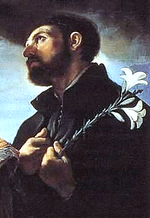Castillo de Javier
| Castillo de Javier | ||
|---|---|---|
|
Javier Castle (2003) |
||
| Creation time : | 10th century | |
| Conservation status: | Rightly restored | |
| Place: | Javier (Navarre) | |
| Geographical location | 42 ° 35 '38.5 " N , 1 ° 12' 57" W | |
|
|
||
The Castillo de Javier ( Castle of Javier ) is a castle in the village of Javier . It is the birthplace of Saint Francisco de Xavier ( Franz Xavier ).
Geographical location
The castle and village are located about 45 kilometers southeast of Pamplona in the Spanish autonomous region of Navarre . The castle is located almost 500 m above the valley of the Aragón River at the foot of the Pyrenees .
history
The origins of the castle go back to the 10th century. At that time a keep was built here, which was later surrounded by a wall. This is still the core of the system today. In the 13th and 14th centuries it was redesigned in the Gothic style. The small castle chapel in the western castle tower, equipped with a Gothic figure of Christ on the cross, is remarkable. The chapel is painted with a dance of death , which is unique in Spain.
The castle was the seat of various noble families such as the Artiedas , the Jaso-Azpilicuetas and the Aznárez . Francisco de Xavier , later canonized and who initiated the Jesuit mission in East Asia, was born here on April 7, 1506 . His mother was born Azpilicueta. After Navarre was taken over by Castile in the 16th century, the family had to lay down the fortifications of the castle on the orders of the king. He distrusted the nobility of the newly won Navarre. The castle was then only used for living until the 19th century. At the end of the 19th century, however, the facility was in ruins.
At that time it was owned by María del Carmen Azlor de Aragón e Idiáquez , Duchess of Villahermosa , and her husband José Manuel de Goyeneche y Gamio , Count of Guaqui. They began to renovate the castle in a romantic way. This could also be continued when the Count suddenly died in 1893. A relatively large neo-Gothic basilica was built to the side of the castle and was consecrated in 1901 . For its construction has been Palacio Nuevo from the Renaissance demolished and then reconstructed. Today the castle shows itself with crenellated Gothic towers and walls that make it look like a toy castle . After the work was completed, the Duchess donated the castle and church to the Society of Jesus at the beginning of the 20th century on condition that it be preserved as it was handed over. Those who contributed to the reconstruction of the castle and the construction of the basilica, including the Duchess, were buried in the crypt of the basilica. After an extensive restoration, the castle became a museum in 1986. As the birthplace of Francisco de Xavier, it is also a place of pilgrimage . The Jesuit Order continues to own the property .
Worth knowing
The castle is a cultural monument ( Bien de Interés Cultural ) due to the Spanish monument law . It is listed in the register of monuments under the number RI-51-0008672.
The castle of Javier has long been the destination of numerous pilgrimages, in early March in honor of the patron saint of Navarre, popularly known as Javierada .
literature
- Dietrich Höllhuber and Werner Schäfke: The Spanish Way of St. James. History and art on the way to Santiago de Compostela . DuMont, [Cologne] 1999. ISBN 3-7701-4862-2
- NN: The castle of Javier [leaflet]. Javier [before 2019].




